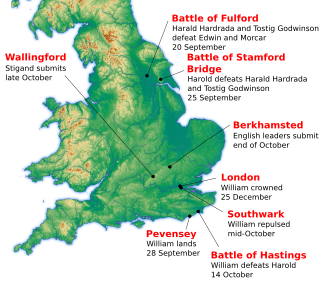A siege tower or breaching tower is a specialized siege engine, constructed to protect assailants and ladders while approaching the defensive walls of a fortification. The tower was often rectangular with four wheels with its height roughly equal to that of the wall or sometimes higher to allow archers to stand on top of the tower and shoot arrows into the fortification. Because the towers were wooden and thus flammable, they had to have some non-flammable covering of iron or fresh animal skins.

The Battle of Hastings was fought on 14 October 1066 between the Norman-French army of William, the Duke of Normandy, and an English army under the Anglo-Saxon King Harold Godwinson, beginning the Norman conquest of England. It took place approximately 7 miles northwest of Hastings, close to the present-day town of Battle, East Sussex, and was a decisive Norman victory.

The Norman Conquest of England was the 11th-century invasion and occupation of England by an army of Norman, Breton, Flemish, and French soldiers led by the Duke of Normandy, later styled William the Conqueror.

The bascinet – also bassinet, basinet, or bazineto – was a Medieval European open-faced military helmet. It evolved from a type of iron or steel skullcap, but had a more pointed apex to the skull, and it extended downwards at the rear and sides to afford protection for the neck. A mail curtain was usually attached to the lower edge of the helmet to protect the throat, neck and shoulders. A visor was often employed from ca. 1330 to protect the exposed face. Early in the fifteenth century, the camail began to be replaced by a plate metal gorget, giving rise to the so-called "great bascinet".

Scottish castles are buildings that combine fortifications and residence, built within the borders of modern Scotland. Castles arrived in Scotland with the introduction of feudalism in the twelfth century. Initially these were wooden motte-and-bailey constructions, but many were replaced by stone castles with a high curtain wall. During the Wars of Independence, Robert the Bruce pursued a policy of castle slighting. In the late Middle Ages new castles were built, some on a grander scale as "livery and maintenance" castles that could support a large garrison. Gunpowder weaponry led to the use of gun ports, platforms to mount guns and walls adapted to resist bombardment.

The great helm or heaume, also called pot helm, bucket helm and barrel helm, is a helmet of the High Middle Ages which arose in the late twelfth century in the context of the Crusades and remained in use until the fourteenth century. The barreled style was used by knights in most European armies between about 1220 to 1350 AD and evolved into the frog-mouth helm to be primarily used during jousting contests.
Steven J. Zaloga is an American historian, defense consultant, and an author on military technology. He received a bachelor's degree cum laude at Union College and a masters degree at Columbia University, both in history.

Hervé, called Frankopoulos or Phrangopoulos, was a Norman mercenary general in Byzantine service during the 1050s.
Robert Crispin, called Frankopoulos, was a Norman mercenary and the leader of a corps of his countrymen stationed at Edessa under the command of the Byzantine general Isaac Komnenos, in the 1060s. He fought against the invading Seljuk Turks and was supposedly poisoned shortly after the Battle of Manzikert.

The nasal helmet was a type of combat helmet characterised by the possession of a projecting bar covering the nose and thus protecting the centre of the face; it was of Western European origins and was used from the Early Middle Ages until the High Middle Ages.
Stephen Richard Turnbull is a specialist in Japanese religious history.

Kasten-brust armour — is a German form of plate armour from the first half of 15th century.

David C. Nicolle is a British historian specialising in the military history of the Middle Ages, with a particular interest in the Middle East.

Adolf, Ritter von Tutschek Pour le Mérite, Royal House Order of Hohenzollern, Iron Cross, Military Order of Max Joseph, was a professional soldier turned aviator who became a leading fighter ace with 27 victories. As German air strategy turned towards concentrated air power, he was entrusted with one of the world's first fighter wings.

The enclosed helmet, also termed a primitive great helm or early great helm, was a type of Western European helmet of the late 12th and early 13th century. It was the forerunner of the great helm.
Leutnant Ludwig Hanstein HOH, Bavaria's MMO was a World War I flying ace credited with 16 aerial victories.
Colonel Alois Heldmann was a World War I flying ace credited with 15 confirmed aerial victories while he was a leutnant. He later joined the nascent Luftwaffe in 1933 and was a flying school inspector through the end of World War II.

The Coventry Sallet is a 15th-century helmet now on display at Herbert Art Gallery and Museum. English sallets have been considered both rare and important.

Warfare in Medieval Scotland includes all military activity in the modern borders of Scotland, or by forces originating in the region, between the departure of the Romans in the fifth century and the adoption of the innovations of the Renaissance in the early sixteenth century. In this period conflict developed from minor raids to major conflicts, incorporating many of the innovations of continental warfare.

Toruń Castle or Thorn Castle is a 13th- or 14th-century castle of the Teutonic Order located in Toruń (Thorn), Poland. The Castle is part of the Medieval Town of Toruń, one of the World Heritage Sites in Poland.














